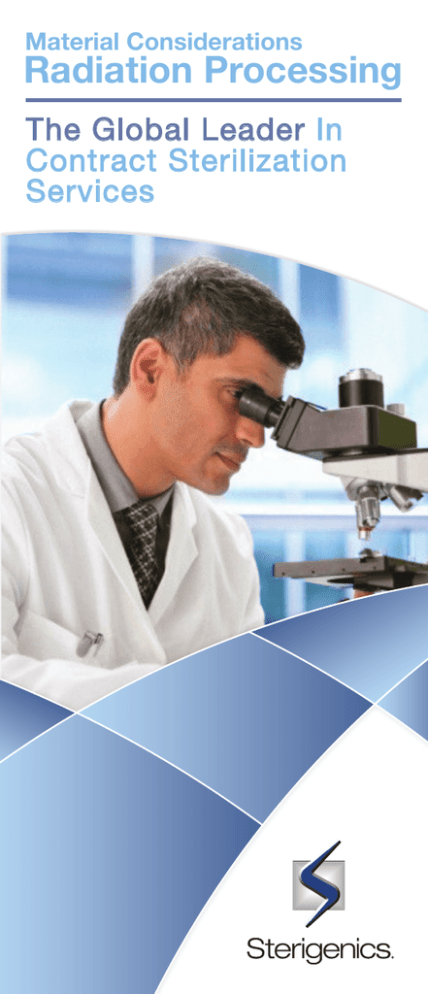
Material Considerations
Radiation Processing
The Global Leader In
Contract Sterilization Services
RADIATION’S EFFECTS
MATERIAL EVALUATION
Radiation interacts with polymers in two ways:
chain scission, which results in reduced tensile
strength and elongation; and crosslinking, which
increases tensile strength but reduces elongation.
Both reactions occur simultaneously, but one is
usually dominant, depending upon the specific
polymer and additives involved.
When weighing the radiation stability of a
polymer and the ultimate success of a component
or medical device, the following factors should
be taken into consideration:
Chain scission classically affects stressed polymers
(containing residual molding stress) to a greater extent
than non-stressed polymers. The combined impact
of solvent-induced stress, residual molding stress
and applied load acts to intensify radiation damage.
Generally, polymers containing aromatic ring
structures (e.g. polystyrene) are resistant to radiation
effects. Aliphatic polymers exhibit degrees of
resistance depending upon their levels of unsaturation and substitution.
Some effects of radiation–such as reduced elongation due to chain scission, may detract from the
device’s performance. Others can be beneficial.
For example, crosslinking of poly- ethylene and
silicones increases tensile strength.
Manufacturers should be cognizant of the possible
impact of radiation on mechanical properties such as
tensile strength, elastic modulus, impact strength and
elongation. Outcomes may influence performance and
should be evaluated in advance by functional testing.
STABILIZERS AND ADDITIVES
Additives and stabilizers are commonly included
in small amounts (less than 1%) in commercial
polymer products to aid in processing, stabilize the
material and impart particular properties to the product.
Tint-based, multi-function stabilizers, for example,
are added to PVCs to counteract the color change
that is typical when this material is irradiated– an
important consideration in situations where color
plays a strong role in customer reaction to the product.
Other additives known as “antirads” function as
antioxidants and help prevent radiation damage.
These additives perform either as reactants, which
readily combine with radiation-generated free
radicals within the polymer, or as primary energy
absorbers, preventing the interaction of the
radiation energy with the polymer itself.
q Stabilizers and antioxidants added to a polymer
can reduce the effects of irradiation on the
product’s mechanical properties and/or
physical appearance
q Thin part sections, thin films and fibers present
in a component or product can allow for excessive
oxygen exposure during the irradiation process,
thus causing degradation of the polymer material
q Residual mold stress present after molding and
assembly of a component or product can
promote molecular scissioning during irradiation
q Highly oriented moldings, which are strong
in the axis of orientation but are already very
weak in the cross-flow axis, will become
weaker after irradiation
q High molecular weight polymers having
low melt flow will survive radiation better
by providing longer molecules and stronger
parts before and after irradiation.
MATERIAL COMPATIBILITY
AND VALIDATION
Each polymer reacts differently to ionizing radiation.
Thus, it is important to verify that the maximum
administered dose will not have a detrimental
effect on the product’s function or the patient’s
safety over the product’s intended shelf life.
Experimental samples of the product should
be irradiated to at least the highest dose to be
encountered during routine processing. For
example, a product which is to receive a sterilizing
dosage of 25 to 40 kiloGray (kGy) should be
tested by dosing samples to at least 40 kGy. A
conservative approach is to irradiate samples at
doses up to twice the anticipated maximum dose.
Since various product applications call for certain
performance properties or functional characteristics,
it is important to test each component or product in an
appropriate manner, using both new and aged material.
Table 2 (over) reviews typical tests of physical
properties. Other tests, which more closely
MATERIAL COMPATIBILITY
AND VALIDATION (CONTINUED)
approximate the actual mechanical application, may
also be employed by the engineering or research staff.
Results of the evaluation should be retained in the
product’s device history file, serving as physical
confirmation that all product claims and specifics
have been met. If product testing indicates a
potentially adverse effect from high levels of
radiation, a maximum permissible dose should be
established by the manufacturer and emphasized
in the specific processing instructions to the
contract sterilizer.
FIGURE A.1
RELATIVE RADIATION STABILITY OF MEDICAL
POLYMER “FAMILIES”
Figure A.1 graphically displays the dose ranges at
which a number of common thermoplastics and
thermosets show significant change in properties
(i.e., a 25% loss in elongation). Loss of elongation
is a commonly used measure of the effect of
irradiation because it equates to a brittleness failure.
Figure A.1 provides a visual means of making an
initial estimate of a polymer’s ability to withstand a
particular radiation sterilization process.
TABLE 2.
PHYSICAL AND FUNCTIONAL TEST METHODS
FOR PLASTICS MATERIAL EVALUATION
Test Method
Test For Embrittleent
1. Tensile properties
a) Tensile strength
b) Ultimate elongation
c) Modulus of elasticity
d) Work
2. Flexural properties
a) Flange bending test
b) Flexbar test
3. Impact resistance
4. Hardness
a) Shore
b) Rockwell
5. Compressive strength
6. Burst strength
7.Tear strength
Test For Discoloration
1. Yellowness index
2. Optical spectrometry
Test References
ISO 527 series
ISO 527 series
ISO 527 series
ISO 527 series
Stability of Irradiated
Polypropylene 1. Mechanical
Properties, Williams, Dunn,
Sugg, Stannet, Advances in
Chemistry Series, No. 169,
Stabilization and Degradation
of Polymers, Eds. Allara,
Hawkins, pp. 142-150, 1978.
ISO 178
ASTM D-1822
ISO 868
ASTM D-785
ISO 604
ASTM F-2054
ASTM D-1004 and ISO 6383-1
ASTM E-313
ASTM D-1746
NOTE Source: International Atomic Energy Agency. Guidelines for
industrial radiation sterilization of disposable medical products. Co-60
gamma irradiation. TEC DOC-539. Vienna IAEA, 1990.
NOTE—HP = high performance; PVC = polyvinylchloride; ABS = acrylonitrile butadiene styrene; PMMA = polymethylmethacrylate;
PP = polypropylene; FEP = Fluorinated ethylene propylene; PTFE =
polytetrafluoroethylene.
TABLE A.1
GENERAL GUIDE TO RADIATION STABILITY OF MATERIALS
Table A.1 shows typical radiation resistances of
medical polymers in stress-free parts measured at
the point where 25% of the polymer’s elongation is
lost because of radiation. This circumstance might
well be the “best case.” If the part being considered
has a significant degree of residual stress as a result
of manufacture, the dose at which the 25% loss of
elongation occurs can be considerably lower.
(•) = poor (••) = fair (•••) = good (••••) = excellent
Material
(NL) = not likely
Single use (<50 kGy)
Comments
Resterilization
(< 100 kGy)
•••
High-impact grades are not as radiation
resistant as standard impact grades
because of the higher butadiene content.
L
•
When irradiated, PTFE and PFA are
significantly damaged. The other fluoropolymers show significantly greater stability.
Some (for example, PVDF) are excellent.
NL
(L) = likely
Comments
Thermoplastics
Acrylonitrile butadiene styrene (ABS)
Fluoropolymers
Polytetrafluoroethylene (PTFE)
Perfluoro alkoxy (PFA)
Perchlorotrifluoroethylene (PCTFE)
Polyvinyl fluoride (PVF)
Polyvinylidene fluoride(PVDF)
Ethylenetetrafluoroethylene (ETFE)
Fluorinated ethylene propylene (FEP)
Polyacetals (e.g., polyoxymethylene)
Polyacrylates (e.g., polymethylmethacrylate)
Polyamides (e.g., nylon)
Polycarbonate (PC)
Polyesters, saturated
Polyethylene (PE), various densities
Polyimides (e.g., polyetherimide)
Polyketones (e.g., polyetheretherketone)
•
••• to ••••
•••
••• to ••••
••• to ••••
••
•
NL
L
L
L
L
NL
Irradiation causes significant chain scission
(i.e., embrittlement). Color changes have
been noted (yellow to green).
•• to •••
NL
NL
•• to •••
Nylon 10, 11, 12, and 6-6 are more stable
than 6. Nylon film and fiber are less resistant.
L
••• to ••••
Yellows—mechanical properties are not
greatly affected; colorcorrected radiation
formulations are available.
L
Polybutylene terephthalate is not as
radiation stable as polyethylene
terephthalate resins.
L
High-density polyethylene is not as
stable as mediumdensity polyethylene
and low-density polyethylene, linear
lowdensity polyethylene.
L
•• to •••
••• to ••••
••••
••••
L
L
Very dependent on design
and use requirements.
TABLE A.1 (CONTINUED) GENERAL GUIDE TO RADIATION STABILITY OF MATERIALS
(•) = poor (••) = fair (•••) = good (••••) = excellent
Material
(NL) = not likely
Single use (<50 kGy)
Comments
Resterilization
(< 100 kGy)
• to ••
Physical properties are greatly reduced
when irradiated (for example, chain
scissioning). Radiation-stabilized grades,
using high molecular weight, copolymerized
and alloyed with polyethylene, with
additional stabilizers should be used
in most radiation applications. Use of
electron beam at high dose rate may
reduce oxidative degradation.
NL
(L) = likely
Comments
Polypropylene (PP)
Natural
Stabilized
Polystyrene (PS)
Polysulfones
•• to •••
••••
••••
Polyurethane (PU)
•• to ••••
Polyvinylacetates (PVA)
Polyvinylchloride (PVC)
PVC, plasticized
Styrene acrylonitrile (SAN)
Will begin to yellow at >50 kGy.
Natural material is yellowish.
Aromatic discolors; polyesters are more
stable than esters. Retains physical
properties.
•••
•••
•••
••• to ••••
NL
L
L
L
NL
Cross-linking dominates and significant
yellow color development occurs at doses
> 30 kGy). Addition of antioxidants and
heat stabilizers to formulations will retard
color development. High-molecular-weight
organotin stabilizers improve radiation
stability: color-corrected radiation
formulations are available.
Cross-linking (stiffening) dominates.
NL
L
L
Significant
discoloration likely.
Discoloration likely.
Thermosets
Epoxy
Phenolics
••••
••••
Polyester, unsaturated
••••
Polyimides
Polyurethanes
Aliphatic
••••
Aromatic
Adhesives
Acrylic
Epoxy
Fluoroepoxy
Silicone
Elastomers
Butyl
Ethylene propylene diene monomer (EPDM)
Natural rubber
Includes the addition of mineral fillers.
Includes the addition of mineral or
glass fibers.
L
Darkening can occur. Possible breakdown
products could be derived.
•• to •••
••••
••••
•• to •••
•
••• to ••••
••• to ••••
L
L
••••
••• to ••••
L
L
L
L
L
L
L
Friable, sheds particulate, chain scission.
NL
L
L
Embrittlement possible.
TABLE A.1 (CONTINUED) GENERAL GUIDE TO RADIATION STABILITY OF MATERIALS
(•) = poor (••) = fair (•••) = good (••••) = excellent
Material
Single use (<50 kGy)
Nitrile
Polyacrylic
••• to ••••
•• to •••
Comments
Discolors.
(NL) = not likely
Resterilization
(< 100 kGy)
Discolors; the addition of aromatic
plasticizers renders the material more stable
to irradiation.
L
Silicone
•• to •••
Cross-linking dominates. Platinum-cured
silicones are superior to peroxidecured
silicones because their preirradiation
cross-link density is greater. Full cure during
manufacture can reduce postirradiation
cross-link effects. Phenyl-methyl silicones
are more stable than are methyl silicones.
L
Styrenic block copolymers (e.g., styrene-butadienestyrene, styrene-ethylenebutylene-styrene)
•• to •••
Butadiene scissions.
L
Urethane
Metals
Aluminum
Brass
Copper
Gold
Magnesium
Nickel
Silver
Stainless steel
Titanium
Ceramics/glasses
Aluminum oxides
Silica
Zirconium oxides
Other materials
Bioabsorbables
Polyglycolides
Polylactides
Cellulosics
Cellulose ester
Cellulose acetate propionate
Cellulose acetate butyrate
Cellulose, paper, cardboard
Liquid crystal polymer (LCP)
••• to ••••
L
••••
••••
••••
••••
••••
••••
••••
••••
••••
L
L
L
L
L
L
L
L
L
••••
••••
••••
L
L
L
• to ••••
• to ••••
NL
NL
••
•• to ••••
•• to ••••
•• to ••••
• to ••••
Esters degrade less than other cellulosics.
Commercial LCPs; natural LCPs are
not stable.
Comments
L
NL
•••
Polychloroprene
(L) = likely
NL
L
L
L
L
Stiffening due to
cross-linking likely.
REFERENCES
Primary sources: International Atomic Energy Agency; NASA/Jet
Propulsion Laboratory; and polymer manufacturers’ literature.
AAMI TIR 17, Compatibility of materials subject to sterilization
(for Table A.1 and Figure A.1).
1 AAMI TIR29, Guide for process characterization and
control in radiation sterilization of medical devices
2 ANSI/AAMI/ISO 11137-1, Sterilization of health
care products—Radiation—Part 1: Requirements
for development, validation, and routine control of a
sterilization process for medical devices.
3 Genova, Hollis, Crowell and Schady, “A Procedure
for Validating the Sterility of an Individual Gamma
Radiation Sterilized Production Batch,” Journal of
Parenteral Science and Technology, Volume 41, No.1, pp.
33-36, Jan 1987.
4 Gaughran and Morrissey, “Sterilization of Medical
Products,” Volume 2, ISBN-0-919868-14-2, pp. 35-39,
1980.
CORPORATE HEADQUARTERS:
Oak Brook, IL USA
Telephone: 1-630-928-1700
www.sterigenics.com
©2015 Sterigenics International. All rights reserved.

